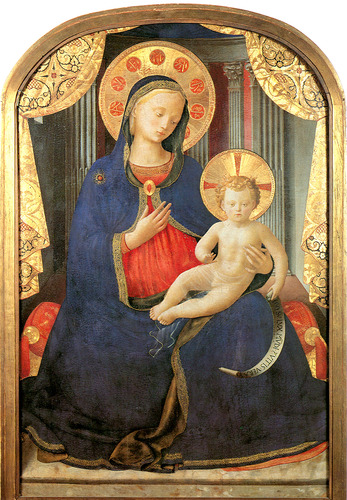
The Life of the Blessed Virgin Mary by Blessed Anne Catherine Emmerich
3. MARY'S MAIDSERVANT AND JOHN THE APOSTLE.
The Blessed Virgin lived here alone, with a younger woman, her maidservant, who fetched what little food they needed. They lived very quietly and in profound peace. There was no man in the house, but sometimes they were visited by an Apostle or disciple on his travels. There was one man whom I saw more often than others going in and out of the house; I always took him to be John, but neither here nor in Jerusalem did he remain permanently near the Blessed Virgin. He came and went in the course of his travels. He did not wear the same dress as in Jesus. time. His garment was very long and hung in folds, and was of a thin grayish-white material. He was very slim and active, his face was long, narrow, and delicate, and on his bare head his long fair hair was parted and brushed back behind his ears. In contrast with the other Apostles, this gave him a womanish, almost girlish appearance. Last time he was here I saw Mary becoming ever quieter and more meditative: she took hardly any nourishment. It was as if she were only here in appearance, as if her spirit had already passed beyond and her whole being was far away. In the last weeks before she died I sometimes saw her, weak and aged, being led about the house by her maidservant.Once I saw John come into the house, looking much older too, and very thin and haggard. As he came in he girt up his long white ample garment in his girdle, then took off this girdle and put on another one, inscribed with letters, which he drew out from under his robe. He put a sort of maniple on his arm and a stole round his neck. The Blessed Virgin came in from her bedchamber completely enveloped in a white robe, and leaning on her maidservant.s arm. Her face was white as snow and as though transparent. She seemed to be swaying with intense longing. Since Jesus. Ascension her whole being seemed to be filled with an ever-increasing yearning which gradually consumed her. John and she went together to the oratory. The Blessed Virgin pulled at the ribbon or strap which turned the tabernacle in the wall to show the cross in it. After they had knelt for a long time in prayer before it, John rose and drew from his breast a metal box. Opening it at one side, he drew from it a wrapping of material of fine wool, and out of this took a little folded cloth of white material. From this he took out the Blessed Sacrament in the form of a small square white particle. After speaking a few solemn words, he gave the Sacrament to the Blessed Virgin. He did not give her a chalice.Behind the house, at a little distance up the hill, the Blessed Virgin had made a kind of Way of the Cross. When she was living in Jerusalem, she had never failed, ever since Our Lord.s death, to follow His path to Calvary with tears of compassion. She had paced out and measured all the distances between the Stations of that Via Crucis, and her love for her Son made her unable to live without this constant contemplation of His sufferings. Soon after her arrival at her new home I saw her every day climbing part of the way up the hill behind her house to carry out this devotion. At first she went by herself, measuring the number of steps, so often counted by her, which separated the places of Our Lord's different sufferings. At each of these places she put up a stone, or, if there was already a tree there, she made a mark upon it. The way led into a wood, and upon a hill in this wood she had marked the place of Calvary, and the grave of Christ in a little cave in another hill. After she had marked this Way of the Cross with twelve Stations, she went there with her maidservant in quiet meditation: at each Station they sat down and renewed the mystery of its significance in their hearts, praising the Lord for His love with tears of compassion. Afterwards she arranged the Stations better, and I saw her inscribing on the stones the meaning of each Station, the number of paces and so forth. I saw, too, that she cleaned out the cave of the Holy Sepulcher and made it a place for prayer. At that time I saw no picture and no fixed cross to designate the Stations, nothing but plain memorial stones with inscriptions, but afterwards, as the result of constant visits and attention, I saw the place becoming increasingly beautiful and easy of approach. After the Blessed Virgin's death I saw this Way of the Cross being visited by Christians, who threw themselves down and kissed the ground.
CONTENTS | NEXT | FOOTNOTESCopyright ©1999-2023 Wildfire Fellowship, Inc all rights reserved

 Keep Site Running
Keep Site Running